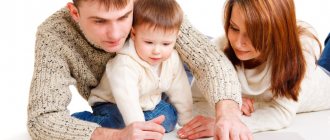How can you help your baby?
There is a lot a mother can do to help her baby prepare for his first steps. You need to understand that the preparatory processes go on for many months - on their own. This is the development of visual-motor coordination, tone and balance, interaction of the hemispheres - by the way, the most important thing here is the process of crawling. Gradually, the child learns to feel the size of his body and studies its mobility. Until all these processes mature, it is too early to walk.
Calcium is a key microelement necessary for the normal development of the skeletal system. Its role is especially important during periods of intensive development and growth of the body. It is important not only the amount of calcium in the product, but also how well it is absorbed by the body. Cottage cheese "Agusha" contains natural vitamin K2, which helps calcium integrate into the baby's bones and teeth.
Preparation stages and your support:
- 4 – 7 months: baby sits. When a child begins to sit without support, this is the first stage of increasing his mobility. Sitting helps strengthen the muscles that will be used in learning to stand on your feet. A very effective and at the same time simple exercise for a child to gain strength is rolling a ball back and forth in front of him. An adult can hold a toy in front of the baby and move it from left to right, stimulating the baby to reach for it in one direction or the other. It is important to allow the necessary muscles to strengthen - soon they will have to work hard.
- 7 – 10 months: baby crawls. The most important thing in the crawling process is to learn to move your arms and legs at the same time. This will come in handy when walking. Help your child master this skill by encouraging him to crawl from one corner of the room to another. Be sure to praise your child for such an achievement! In the process of crawling, the muscles of the neck, back, arms and legs are strengthened. There is also more control over the hips, the muscles of which will be used when lifting up and down on your legs.
- 8 – 9 months: the baby pulls himself up, holding onto a support, and stands on his feet. The baby's muscles become stronger and are now able to support the weight of the entire body. The child becomes more curious, and, feeling the strength in the body, he will begin to reach up, grabbing the furniture, the side of the crib, or his parents. Now is the time to help him begin to catch the first hints of a sense of balance in an upright position on his feet. Help your child learn to pull himself up. The baby must understand that this movement is the opposite of the one he performs when he lowers himself from a standing position to a sitting position.
- 8 – 10 months: the baby walks with your support using two hands. When your child begins to stand on his feet and maintain his balance (without letting go of your hands yet), help him take a few steps. From time to time you can remove one hand so that the baby learns to maintain balance. Practice is everything here - there should be as much of it as possible. Do not limit your child’s movement: the more opportunities he has to practice standing on his feet, the easier it will be for him to decide to take his first independent steps.
- 9 – 10 months: the baby walks independently along the support. The child moves along the side of the crib, furniture and walls. Make sure the apartment is safe for such travel. Encourage your baby to let go of the support for a while - to lift his hands off the wall. Don't forget: you have to fall softly! The impact will be softened by the carpet and diaper. Place your child's favorite toys throughout the space available to him and encourage the baby with encouragement and praise if he tries to reach them using the wall and furniture. The space on the floor must be cleared of unnecessary items.
- 9 – 11 months: the baby gets up independently and stands without support or support. Balance is the most important thing in walking. If a child can stand and balance for a few seconds, this is a signal that, apparently, the baby will soon decide to take his first steps. Turn balancing into a game: sit on the floor with your child and help him get to his feet. Count how long he can stand on his feet before he begins to lose his balance. Praise every attempt.
If you do not interfere with the natural development of the child, he will decide for himself when to get up and go. If he doesn’t do this, then something is stopping him: there is no physical strength or the very motive to walk. If a child is normally developed, but has no desire to walk, perhaps the baby is overprotected, everything is brought to him on demand - that is, he has no incentive to move in space.
- 9 – 16 months: baby takes first steps without support. The first steps are a great thing. The most important thing at this stage for the child is to learn to lift his leg while maintaining balance on the other. Pay attention to him: every step deserves vigorous praise and encouragement. Compared to how the muscles work when standing, when walking the muscles of the hips and knees should be more relaxed, this is what the baby has to understand now. You can sit on the floor and, encouraging your child, slowly guide him until he regains his balance and tries to walk without you.
- 12 – 16 months : the child walks. He won’t be able to walk on the first try; he will stumble more than once or twice before he can move smoothly and without hesitation. Encourage your child to explore his or her capabilities in every way. Praise, praise, praise. And don't forget that some babies will choose to return to crawling occasionally until they gain confidence in their abilities. Encourage walking. For example, when lowering a child from your arms down, put him on his feet, and do not sit him on the floor.
To make it easier for your child to learn to walk, you need to create the necessary conditions for this and prepare a safe space around him. Let's talk about this.
How do you know if your baby is late taking his first step?
It should be noted right away that premature babies always begin to walk much later than full-term ones. The timing for such babies is shifted to six months and the first step is closer to two years - this is the norm. More details about the development of premature babies in the article: “Premature baby and its development. How to deliver a premature baby? Recommendations for care." As for standard development, a year and a half is too late for the first step.
Why does this happen?
Quite often the cause lies in neurological or physiological disorders. As soon as your child gets on his feet, pay attention to:
- feet, how they are formed;
- how crooked the legs are;
- how he places his feet (toes apart or inward);
- Is he clumsy?
If there are such symptoms, be sure to show him to an orthopedist and neurologist. But don’t panic right away, as the delay in the skill can be affected by:
- genetic predisposition, if mom or dad started walking late, then you shouldn’t expect the baby to go early;
- excess weight does not allow the toddler to support his body on his feet;
- temperament, phlegmatic children with slow manners always start walking later;
- lack of vitamin D (rickets), this affects the child’s musculoskeletal system. How to recognize rickets in time, read the article: “Symptoms of rickets in children”;
- A bad experience on your first trip quite often becomes the reason for fear of going again. In such cases, young parents are simply obliged to teach their child to walk.
How to teach a child to walk ? Preparatory stage
In order to teach a child to walk, you need to develop muscles ahead of time. After all, the development of the musculoskeletal system begins in the first months of life. Therefore, it is necessary to prepare the newborn’s body for future stress long before starting to teach the child to walk. The preparatory stage of development consists of simple procedures that can accelerate physical development:
- Starting at two months of age, encourage your baby to try to roll over to his side. Such movements contribute to the development of muscles in the back, arms, legs, and neck. You can teach how to do this with the help of a toy. Initially, hold the toy over the baby, then place it on the bed. The baby, interested, will turn behind her.
- Place the newborn on his stomach. Actively use this method when the little one learns to roll over. This type of lying strengthens the neck and back muscles. In addition, do not forget about massage; learn how to do it from the article: “Massage for a newborn.”
- Before your little one tries to sit down, teach him to pull himself up. To do this, let him grab your index fingers with his hands. Then pull the baby up as if sitting down. Such exercises can be carried out at 4-5 months before bathing.
- In order to stimulate action and teach the child to walk, after he learns to sit on his own, invite him to reach for the toy by stretching. Also offer to crawl to it. Come up with tasks for your child so that he doesn’t stay in one place for a long time.
- To teach a child to walk, his legs must be strong, so conduct classes on bending and straightening the knees. This should be done through gymnastics, as well as jumping with your help (holding him by the armpits).
Movement is life
- The child needs to move a lot. Do gymnastics with your baby, go swimming, surround him with attractive stimuli that make him move. Playpens, walkers, long walks in a stroller while awake, and other ways to restrain your baby and ensure safety all reduce your anxiety, but interfere with your baby's development.
- Give your child a chance to show what he is capable of. In order not to delay the first steps, do not pick up the child when you want to move him from place to place. On the contrary, encourage him to try to move around on his own instead of always relying on you.
- Consider the child's characteristics. It happens that quite well physically developed children do not show enough interest in walking. Of course, temperament is important: calm children are in no hurry to take their first steps, unlike their more active peers, just like large babies in comparison with short and slender peers.
- A child should have a reason to get up and go. Develop and encourage independence: you won’t always be there for him, it’s time to little by little learn to achieve what he wants himself! Try to interest your child in something that is above floor level. For example, if your child plays with toys on the floor, place some of them on a coffee table or bookshelf above floor level. You can also place toys not in one place in the nursery, but distribute them at the child’s eye level throughout the available space. This can increase motivation to learn walking skills.
- Let your child learn on his own. If mom, dad or older relatives try to protect the child from falling - for example, holding the back of his head with his palm - this leads to imbalance. The baby, instead of aligning his axis vertically, leaning on his legs, springing and swaying from side to side, begins to transfer part of his weight to the adult’s palm and fall back without support. The child must learn to walk on his own. This is his job, assistants will only get in the way.
Factors influencing the timing of skill acquisition when children begin to walk
- The first point concerns genetics. That is, a child usually inherits the physiological characteristics of his parents and grandparents.
- But individual characteristics, that is, physiology, can be formed depending on the physical condition and body weight.
- Temperament, , is also of great importance . Chubby, heavy children in the early stages of development may find it more difficult to maintain their weight, but they are more likely to sit and watch something rather than move actively.
After a healthy baby has taken his first steps, parents should watch him closely and note any unnatural movements. If anything seems suspicious, you should immediately consult an orthopedic doctor.
Keep in mind that the first steps will be a little awkward.
But keep in mind that from the first day, children do not begin to walk at the required pace, like an adult. And that's completely normal! That is:
- children often place their legs parallel to each other;
- Sometimes babies go clubbing. This requires the attention of a doctor, but purely for consultation purposes. As a rule, this phenomenon goes away over time;
- they do not know how to “roll” from heel to toe. If you look closely, they seem to “reprint” the trace;
- babies sometimes put their legs on their side. Especially if the baby learned to run in a walker. Over time this will even out. But do not lose sight of such a phenomenon, so as not to miss dangerous calls;
- At the beginning of school, children can walk “on tiptoes.” And this is also normal!
In conclusion, it is worth giving one more instruction - the child knows best when he needs to start walking! Therefore, enjoy every moment and do not rush things. If you really want to play the game “raise all surrounding objects higher” with your child, then it’s better to do more gymnastics and massage procedures with him!
Learning to fall correctly
Yes, it hurts for a mother to watch her baby fall. But don't forget: falling is part of the job and the best incentive for developing balance. If a baby is constantly being caught and belayed, how will he learn to fall safely? Even if the child is crying, you should not feel too sorry for him: after a while he will calm down and again try to get up and walk. Without interfering in this process, you give him the opportunity to experience the experience of overcoming himself and defeating failures, without which he will not learn to achieve his goal.
However, some falls can still be prevented—falls on slippery floors. To do this, allow the child to walk with bare feet or wearing special socks with rubberized soles.
An additional factor that will work in favor of walking is the inclusion of a sufficient amount of calcium-containing foods in the child’s diet. During this period, it is very important to support the growing body with nutrition aimed at strengthening bones and ligaments.
And lastly, have fun! Turn on music and dance more often - the child will repeat the movements after you, squatting, springing and making turns. This will strengthen his legs and back and help him learn to walk.
When can a child be taught to walk?
Before teaching your child to walk, you should make sure that your back is strong. The best training for the spinal muscles and the entire musculoskeletal system is active crawling, as well as independent sitting. There are exceptions when the toddler begins to walk without crawling, but this is not always good. By 9–10 months, most children are already crawling with all their might and trying to stand on their feet. But these are not strict standards, because everything depends on individual characteristics. The first attempts to stand independently occur near the support, then the hands let go of it, then the first step follows with holding, and in the finale the baby moves his legs without support. What time does this happen?
It is difficult for specialists to answer, since many factors influence walking skills, but the framework of conventional norms exists and they show that a normally developing baby without deviations should learn to walk from 9 months to 1 year and 3 months.
Making the house safe for children
It is very important to take a responsible approach to creating a safe home that will become a learning and developmental environment for the child. What can you do to make your child's space safe?
- Make sure the floor is soft. You can lay a carpet or other covering on the floor, securely fixed so that the baby cannot trip over it.
- Sockets must have plugs.
- It is important to hide the wires in the baseboards.
- Use door stops.
- Install latches, locks, and latches on the doors of cabinets and bedside tables to prevent your child from getting their fingers pinched by the door.
- The exit to the stairs (if there are any in the house) must be blocked with a special gate.
- Remove all knives, utensils and any breakable items.
- Keep hot food and drinks away from the edge of the table.
- Eliminate all access to chemicals for cleaning your home.
- Use special plugs for taps.
- Install a lock on the toilet seat.
- Keep trash containers closed.
- The first aid kit with medicines should move as far and high as possible.
- Block access to any large furniture that could be knocked over.
- Use silicone protection for sharp corners of furniture.
- Place all electrical appliances out of reach of the baby.
- No access to gas valves.
- Remove all fire equipment.
Now for any household problem there is a solution and special devices for all occasions, which you can either buy or make yourself. Let your home not be so elegant and filled with cute little things for some time, but you won’t have to constantly fix your attention on the child and worry.
Shoes for first steps: pros and cons
The right shoes for the first step - what should they be? Here the opinions of domestic and foreign experts differ. Western pediatricians believe that when a child walks indoors, it is better to leave his feet bare: this way the ankle is better trained. Russian doctors, as soon as they find out that the child is going to walk, prescribe shoes with arch supports and a hard, high heel. It is believed that such shoes help prevent flat feet. To make an informed decision, consult with an orthopedist; if the child has no indications for special orthopedic shoes, then you have more arguments in favor of bare feet at home. Or socks with rubberized soles if the floor is cold. The choice is yours - your opinion is decisive here.











